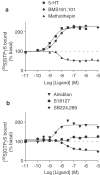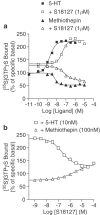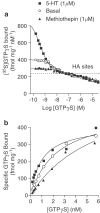h5-HT(1B) receptor-mediated constitutive Galphai3-protein activation in stably transfected Chinese hamster ovary cells: an antibody capture assay reveals protean efficacy of 5-HT
- PMID: 12684263
- PMCID: PMC1573751
- DOI: 10.1038/sj.bjp.0705140
h5-HT(1B) receptor-mediated constitutive Galphai3-protein activation in stably transfected Chinese hamster ovary cells: an antibody capture assay reveals protean efficacy of 5-HT
Abstract
1. Serotonin 5-HT(1B) receptors couple to G-proteins of the Gi/o family. However, their activation of specific G-protein subtypes is poorly characterised. Using an innovative antibody capture/guanosine-5'-0-(3-[(35)S]thio)-triphosphate ([(35)S]GTPgammaS) binding strategy, we characterised Galpha(i3) subunit activation by h5-HT(1B) receptors stably expressed in Chinese hamster ovary (CHO) cells. 2. The agonists, 5-HT, alniditan and BMS181,101, stimulated Galpha(i3), whereas methiothepin and SB224,289 behaved as inverse agonists. The selective 5-HT(1B) receptor ligand, S18127, modestly stimulated Galpha(i3) and reversed the actions of both 5-HT and methiothepin. S18127 (1 micro M) also produced parallel, dextral shifts of the 5-HT and methiothepin isotherms. 3. Isotopic dilution experiments ([(35)S]GTPgammaS versus GTPgammaS) revealed high-affinity [(35)S]GTPgammaS binding to Galpha(i3) subunits in the absence of receptor ligands indicating constitutive activity. High-affinity [(35)S]GTPgammaS binding was increased 2.8-fold by 5-HT with an increase in the affinity of GTPgammaS for Galpha(i3) subunits. In contrast, methiothepin halved the number of high-affinity binding sites and decreased their affinity. 4. h5-HT(1B) receptor-mediated Galpha(i3) subunit activation was dependent on the concentration of NaCl. At 300 mM, 5-HT stimulated [(35)S]GTPgammaS binding, basal Galpha(i3) activation was low and methiothepin was inactive. In contrast, at 10 mM NaCl, basal activity was enhanced and the inverse agonist activity of methiothepin was accentuated. Under these conditions, 5-HT decreased Galpha(i3) activation. 5. In conclusion, at h5-HT(1B) receptors expressed in CHO cells: (i) inverse agonist induced inhibition of Galpha(i3), and its reversal by S18127, reveals constitutive activation of this Galpha subunit; (ii) constitutive Galpha(i3) activation can be quantified by isotopic dilution [(35)S]GTPgammaS binding and (iii) decreasing NaCl concentrations enhances Galpha(i3) activation and leads to protean agonist properties of 5-HT: that is a switch to inhibition of Galpha(i3).
Figures




References
-
- AUDINOT V., NEWMAN-TANCREDI A., CUSSAC D., MILLAN M.J. Inverse agonist properties of antipsychotic agents at cloned, human (h) serotonin (5-HT)1B and h5-HT1D receptors. Neuropsychopharmacology. 2001a;25:410–422. - PubMed
-
- AUDINOT V., NEWMAN-TANCREDI A., MILLAN M.J. Constitutive activity at serotonin 5-HT1D receptors: detection and quantification by homologous [35S]-GTPγS versus GTPγS binding isotherms. Neuropharmacology. 2001b;40:57–64. - PubMed
-
- BAE H., ANDERSON K., FLOOD L.A., SKIBA N.P., HAMM H.E., GRABER S.G. Molecular determinants of selectivity in 5-hydroxytryptamine 5-HT1B receptor-G-protein interactions. J. Biol. Chem. 1997;272:32071–32077. - PubMed
-
- BARNES N.M., SHARP T. A review of central 5-HT receptors and their function. Neuropharmacology. 1999;38:1083–1152. - PubMed
-
- BERG K.A., STOUT D.B., CROPPER J.D., MAAYANI S., CLARKE W.P. Novel actions of inverse agonists on 5-HT2C receptor systems. Mol. Pharmacol. 1999;55:863–872. - PubMed
MeSH terms
Substances
LinkOut - more resources
Full Text Sources

